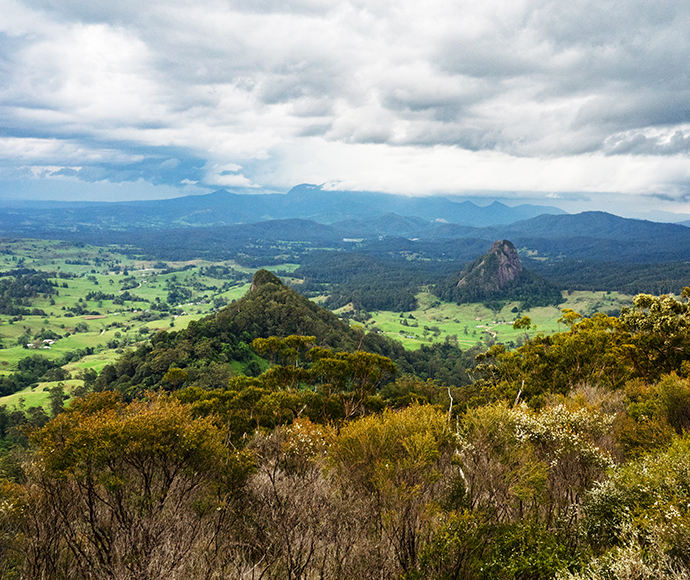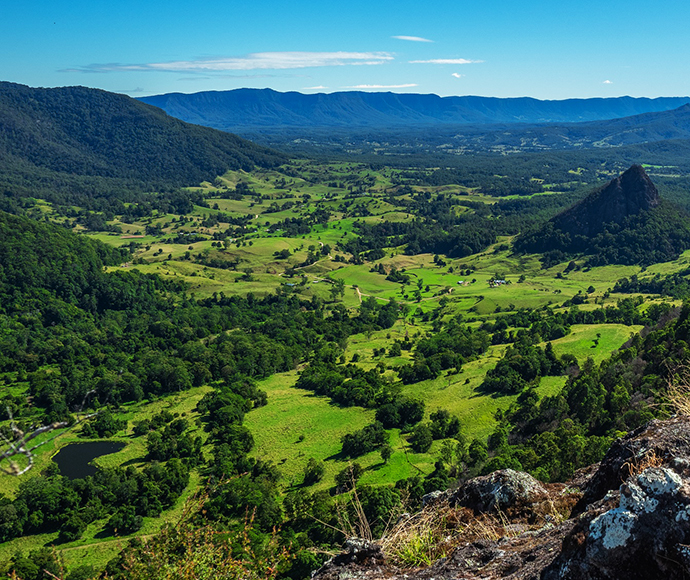We are planning the Caldera Rim Walk in Wollumbin National Park and invited community feedback on the draft master plan. The public consultation has now closed.
The Caldera Rim Walk draft master plan provides overarching concepts for the proposed 8-kilometre (return) half-day bushwalk and associated facilities in Wollumbin National Park.
The proposed walk would be a Grade 4 hiking track in accordance with the Australian Walking Track Grading system, offering a challenge to bushwalkers, climbing over 500 metres in elevation to the top of the inner Tweed Caldera, through rainforest, wet sclerophyll and drier eucalypt forest, showcasing spectacular views of the Wollumbin summit and surrounding caldera.
With easy access from Murwillumbah and Tyalgum, the proposed Caldera Rim Walk would be accessed from Tyalgum Road, along the existing Tweed Hinterland Rainforest Way Scenic Drive.
The draft master plan also suggests possible future options to extend the walk, which would expand the integrated visitor experiences in the area and cater for a diverse range of bushwalking experiences.

Wollumbin Caldera
The Caldera Rim Walk is underpinned by 4 principles:
- Conservation:
- Protecting fauna and flora species.
- Protecting and enhancing cultural, natural and social values.
- Managing the environmental impacts of visitors.
- Developing an educational focus for the walk that will foster an improved understanding of conservation and encourage future stewardship of national parks.
- Selecting an alignment and sustainable track design, material selection and construction techniques that will minimise impacts to biodiversity values.
- Culture and heritage:
- Protecting and enhancing cultural, natural and heritage assets.
- Providing a visitor experience and facilities that interpret, foster education and awareness.
- Respecting the Aboriginal and natural heritage in the region and highlight the park's significant cultural connection and natural attributes as part of UNESCO Gondwana Rainforests.
- Communities:
- Introducing new park experiences and facilities for community benefit.
- Delivering local economic benefits by increasing visitation, dwell time and overnight stays in the region.
- Providing opportunities for service partnerships and local jobs through the walking track project.
- Experiences:
- Providing an experience for a range of visitors that builds high-quality, memorable connections with the natural environment and cultural landscape in Wollumbin National Park.
The draft master plan has now closed for public comment.
The NSW National Parks and Wildlife Service will review all submissions and prepare a submissions report.
The draft master plan may be adjusted according to:
- feedback received in submissions
- environmental and cultural assessments
- further technical and detailed design investigation.
The final Caldera Rim Walk master plan and submissions report will be available online.
If you made a submission, we'll let you know when the final plan and submissions report are available.
A master plan is a non-statutory document that outlines a vision to guide how an area may evolve with visitor infrastructure and experiences.
It is important to note that our draft master plan is conceptual. We are seeking community input to refine our vision in advance of the detailed design and environmental planning approval stages.
The next stage of the project is a detailed design and environmental and cultural assessment for the development of the walk.
The final master plan and its delivery will be consistent with the Parks and Reserves of the Tweed Caldera Plan of Management.
A review of environmental factors (REF) will be prepared to assess the environmental and cultural significance of the project area and likely environmental impacts of the proposal and identifies measures to mitigate the adverse effects of the detailed design.
We will continue to update you on the project's progress. Anyone who has not yet registered to receive project updates on Wollumbin National Park can do so on the project webpage.

Wollumbin and Mount Doughboy from Doon Doon saddle, Mount Jerusalem National Park